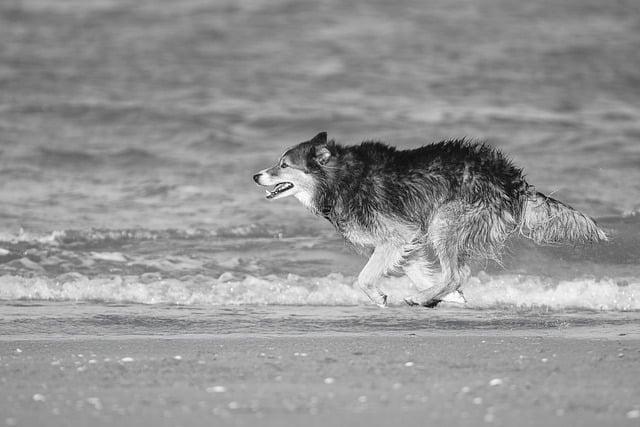As the sun dipped below the horizon, Sarah watched her golden retriever, Max, eagerly finish his dinner. But a nagging doubt crept in: was she feeding him enough? She recalled the vet’s advice: “A healthy dog should have energy, a shiny coat, and a playful spirit.” With a quick check of Max’s weight and a glance at his food bowl, she realized that portion sizes matter. By monitoring his body condition and adjusting his meals, she ensured Max thrived. Remember, a well-fed dog is a happy dog—your furry friend deserves the best!
Contents
- Understanding Your Dogs Nutritional Needs for Optimal Health
- Recognizing Signs of Underfeeding and Overfeeding in Your Dog
- Evaluating Portion Sizes and Feeding Frequency for Your Dogs Lifestyle
- Consulting with Veterinarians for Tailored Dietary Recommendations
- Q&A
Understanding Your Dogs Nutritional Needs for Optimal Health
Determining whether your dog is receiving the right amount of food can be a challenging task, but understanding their nutritional needs is essential for their overall health and well-being. Start by considering your dog’s age, breed, size, and activity level, as these factors significantly influence their caloric requirements. Puppies, for instance, require more energy-dense food to support their rapid growth, while senior dogs may need fewer calories to maintain a healthy weight.
Another critical aspect to evaluate is the quality of the food you are providing. Not all dog foods are created equal; some may contain fillers and low-quality ingredients that do not meet your dog’s nutritional needs. Look for **high-quality dog food** that lists meat as the first ingredient and contains a balanced mix of proteins, fats, carbohydrates, vitamins, and minerals. This ensures that your dog is not only getting enough calories but also the right nutrients to thrive.
Monitoring your dog’s body condition score (BCS) is an effective way to assess whether you are feeding them adequately. A healthy dog should have a defined waist when viewed from above and should not have excessive fat covering their ribs. Regularly check your dog’s weight and adjust their food intake accordingly. If your dog is gaining or losing weight unexpectedly, it may be time to consult your veterinarian for tailored advice on their dietary needs.
Lastly, consider your dog’s behavior and energy levels as indicators of their nutritional status. A well-fed dog should exhibit a healthy level of energy, be active during playtime, and maintain a good mood. If you notice signs of lethargy, excessive hunger, or changes in behavior, it may be a signal that their diet needs adjustment. Always remember that a balanced diet is the cornerstone of your dog’s health, and making informed choices about their nutrition will lead to a happier, healthier life.
Recognizing Signs of Underfeeding and Overfeeding in Your Dog
Understanding your dog’s nutritional needs is crucial for their overall health and well-being. Recognizing the signs of underfeeding and overfeeding can help you make informed decisions about their diet. If your dog is underfed, you may notice **weight loss**, **excessive hunger**, and **low energy levels**. These symptoms can lead to more serious health issues if not addressed promptly. Keep an eye out for a **prominent ribcage** or a **sunken appearance** around the eyes, which can indicate that your furry friend is not getting enough nourishment.
On the other hand, overfeeding can also pose significant risks to your dog’s health. Signs of overfeeding include **weight gain**, **lethargy**, and **increased thirst**. You might observe that your dog has difficulty moving or playing, which can be a direct result of excess weight. Additionally, watch for **gastrointestinal issues** such as vomiting or diarrhea, which can occur when a dog consumes more food than their body can handle. Maintaining a healthy weight is essential to prevent conditions like diabetes and joint problems.
To ensure your dog is receiving the right amount of food, consider their **age**, **activity level**, and **breed**. Puppies, for instance, require more calories for growth, while senior dogs may need fewer calories to maintain a healthy weight. Adjusting portion sizes based on these factors can help you strike the right balance. Regularly consulting with your veterinarian can provide tailored advice on your dog’s specific dietary needs, ensuring they thrive at every stage of life.
Monitoring your dog’s body condition score (BCS) can also be an effective way to assess their feeding regimen. A BCS scale typically ranges from 1 to 9, with 4 to 5 being ideal. You can evaluate your dog’s BCS by feeling their ribs and observing their waistline. If you can easily feel their ribs without excess fat covering, they are likely at a healthy weight. Conversely, if you cannot feel their ribs or if they have a noticeable bulge, it may be time to reassess their feeding habits. Keeping a close watch on these indicators will help you maintain your dog’s health and happiness.
Evaluating Portion Sizes and Feeding Frequency for Your Dogs Lifestyle
Understanding the right portion sizes for your dog is crucial to ensuring their health and well-being. Each dog is unique, with factors such as age, breed, weight, and activity level playing significant roles in determining their nutritional needs. To start, consider the following guidelines:
- Consult Feeding Guidelines: Most dog food brands provide feeding charts based on your dog’s weight and age. Use these as a baseline, but remember that individual needs may vary.
- Monitor Body Condition: Regularly assess your dog’s body condition score (BCS). A healthy dog should have a visible waist and ribs that can be felt but not seen. Adjust portions accordingly if your dog is overweight or underweight.
- Consider Activity Level: Active dogs require more calories than their sedentary counterparts. If your dog participates in regular exercise or play, you may need to increase their portion sizes to meet their energy demands.
- Age Matters: Puppies, adults, and senior dogs have different nutritional requirements. Puppies need more frequent feedings and higher calorie content, while seniors may require less food and more easily digestible options.
Feeding frequency is another essential aspect of your dog’s diet. While some pet owners prefer to feed their dogs once a day, others may find that multiple smaller meals work better for their pet’s lifestyle. Consider these factors when determining the best feeding schedule:
- Digestive Health: Smaller, more frequent meals can aid digestion and help prevent issues like bloating, especially in larger breeds.
- Behavioral Considerations: Dogs that are prone to anxiety or excitement may benefit from a more structured feeding routine, which can provide comfort and stability.
- Weight Management: If your dog is overweight, spreading their daily caloric intake across multiple meals can help control hunger and prevent overeating.
- Personal Schedule: Choose a feeding frequency that fits your lifestyle. Consistency is key, so whatever schedule you choose, try to stick to it as closely as possible.
Ultimately, the goal is to find a balance that supports your dog’s health while fitting seamlessly into your daily routine. Regularly reassess your dog’s weight and overall condition, and don’t hesitate to consult your veterinarian for tailored advice. They can provide insights based on your dog’s specific needs, ensuring that you are not only meeting but exceeding their nutritional requirements.
- Keep a Feeding Journal: Documenting your dog’s meals, portion sizes, and any changes in behavior or weight can help you make informed adjustments over time.
- Be Mindful of Treats: Treats should account for no more than 10% of your dog’s daily caloric intake. Factor these into their overall diet to avoid unintentional overfeeding.
- Stay Informed: Nutrition science is always evolving. Stay updated on the latest research and recommendations to ensure your dog receives the best possible care.
Consulting with Veterinarians for Tailored Dietary Recommendations
When it comes to ensuring your dog receives the right nutrition, consulting with a veterinarian is an invaluable step. Veterinarians possess the expertise to assess your dog’s specific needs based on factors such as age, breed, weight, and activity level. By collaborating with a professional, you can develop a tailored dietary plan that addresses your dog’s unique health requirements, ensuring they thrive at every stage of life.
During your consultation, be prepared to discuss your dog’s current diet and any concerns you may have regarding their eating habits. A veterinarian can help identify potential deficiencies or excesses in their nutrition. They may suggest adjustments to portion sizes, recommend high-quality food brands, or even propose specialized diets for dogs with specific health conditions. This personalized approach not only enhances your dog’s well-being but also fosters a stronger bond between you and your furry companion.
Moreover, regular check-ups with your veterinarian can help monitor your dog’s weight and overall health. As your dog ages or their lifestyle changes, their dietary needs may evolve. A veterinarian can provide ongoing support and adjustments to their diet, ensuring that they receive the right balance of nutrients. This proactive approach can prevent obesity and related health issues, ultimately leading to a longer, healthier life for your pet.
In addition to dietary recommendations, veterinarians can offer guidance on feeding schedules and portion control. They can help you understand the importance of measuring food accurately and recognizing signs of hunger or fullness in your dog. By implementing their advice, you can create a structured feeding routine that promotes healthy eating habits and prevents overindulgence. Trusting a veterinarian’s expertise is a crucial step in providing your dog with the nutrition they need to flourish.
Q&A
-
What factors should I consider when determining my dog’s food intake?
To ensure your dog is receiving the right amount of food, consider the following factors:
- Age: Puppies, adults, and seniors have different nutritional needs.
- Weight: Maintain a healthy weight by adjusting portions accordingly.
- Activity Level: Active dogs require more calories than sedentary ones.
- Breed: Some breeds have specific dietary requirements.
-
How can I tell if my dog is at a healthy weight?
To assess your dog’s weight, perform the following checks:
- Rib Check: You should be able to feel your dog’s ribs without excess fat covering.
- Waist Check: Look for a noticeable waist when viewed from above.
- Body Condition Score: Use a scoring system to evaluate your dog’s overall condition.
-
What signs indicate that my dog is not getting enough food?
Watch for these signs that may suggest your dog is underfed:
- Weight Loss: Noticeable decrease in body weight or muscle mass.
- Low Energy: Lethargy or decreased activity levels.
- Increased Hunger: Constant begging or scavenging for food.
-
Should I consult a veterinarian about my dog’s diet?
Absolutely! Consulting a veterinarian is crucial for:
- Personalized Advice: Tailored recommendations based on your dog’s specific needs.
- Health Monitoring: Regular check-ups to ensure your dog remains healthy.
- Diet Adjustments: Guidance on adjusting food intake as your dog ages or changes activity levels.
ensuring your dog receives the right amount of food is crucial for their health and happiness. By monitoring their weight, activity level, and overall well-being, you can confidently provide the nourishment they need to thrive. Your furry friend deserves the best!

大家好,我是彼得潘,專業的手法身體治療師。我喜歡探索和研究各種主題,並透過與人工智慧的合作分享專業、實用、有趣的文章。我們定期進行人工審核,以確保內容的準確性。如果您發現文章中有任何不準確的地方,請隨時與我們聯繫,我們會及時糾正。您可以透過 [email protected] 與我們聯繫。



